Tensions Rise: NYPD Engages with Columbia University Protesters
New York Police Department (NYPD) officers clashed with student protesters at Columbia University this week, escalating tensions over campus activism and law enforcement’s role in academic spaces. The confrontation occurred Wednesday afternoon when demonstrators gathered to protest university policies, prompting NYPD intervention amid concerns about public safety. The incident has reignited debates about free speech, police presence on campuses, and the boundaries of student advocacy.
Escalation at Campus Demonstration
Approximately 300 students and activists assembled on Columbia’s Morningside Heights campus, voicing demands related to university investments and campus policies. By 3 p.m., the peaceful gathering turned tense when protesters blocked access to a university building. NYPD officers, called by campus security, arrived in riot gear and attempted to disperse the crowd using:
- Verbal warnings through bullhorns
- Physical barriers to separate groups
- Limited use of crowd control techniques
Eyewitness accounts describe conflicting versions of events. “The police response was disproportionate from the beginning,” stated Jessica Morales, a senior sociology major. “We were exercising our right to peaceful assembly when they started pushing people.”
Historical Context of Campus Protests
Columbia University has a storied history of student activism dating back to the 1968 protests against the Vietnam War. Recent years have seen increased campus demonstrations nationwide, with student-led movements focusing on:
- Climate change policies
- Racial justice initiatives
- University endowment transparency
- Campus safety reforms
According to the Foundation for Individual Rights and Expression (FIRE), campus protests increased by 32% between 2019-2023, with private universities like Columbia accounting for 61% of high-profile demonstrations.
Law Enforcement Perspective on Campus Safety
NYPD Chief of Department Jeffrey Maddrey defended the police response in a press briefing Thursday morning. “Our officers showed remarkable restraint given the circumstances,” Maddrey stated. “When campus security feels overwhelmed, we have a responsibility to protect all individuals and property.”
The department reported three minor injuries among officers and five arrests for disorderly conduct. University officials emphasized their commitment to both free expression and campus safety in a joint statement with the NYPD.
Student and Faculty Reactions
The incident has divided the Columbia community. A faculty petition condemning the police presence garnered 127 signatures within 24 hours, while some students expressed support for maintaining order on campus.
“There’s a difference between protest and disruption,” argued computer science professor Dr. Alan Vickers. “The university must balance competing interests, but classroom access shouldn’t become collateral damage in these situations.”
Meanwhile, the student activist group Columbia Solidarity Network announced plans for further demonstrations, calling the police intervention “an unacceptable suppression of dissent.”
Legal and Policy Implications
Legal experts note the complex jurisdictional issues surrounding police involvement on private university campuses. Columbia’s status as a private institution creates different legal parameters than public universities regarding:
- First Amendment protections
- Police authority
- Protest permits
- University liability
Education policy analyst Deborah Fowler suggests the incident may prompt reevaluation of university protocols. “This isn’t just about Columbia,” Fowler noted. “Administrations nationwide are watching how these situations unfold to inform their own crisis response plans.”
Next Steps and Ongoing Dialogue
University President Minouche Shafik announced the formation of a task force to review protest policies and police relations. The group, comprising students, faculty, and security experts, will deliver recommendations by semester’s end.
As tensions persist, community forums have been scheduled to address concerns from all stakeholders. The NYPD has agreed to participate in de-escalation training sessions with campus security, while student organizers plan teach-ins about protest rights.
This developing situation reflects broader national conversations about activism, security, and institutional responsibility. Readers seeking to understand their rights in campus protests can consult the American Civil Liberties Union’s guide to student protest rights for authoritative information.
See more Update My News



